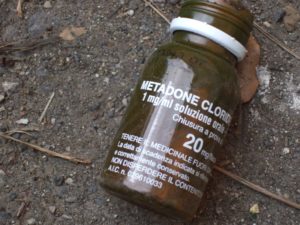
There are currently 146,00 individuals in treatment for opiate dependency (OD) in England. That is 52% of all individuals in drug and alcohol treatment. The first-line treatment for OD, as recommended by NICE (2007) and WHO (2009) is opiate substitution therapy (OST). This involves prescribing a long-acting opiate, such as methadone or, less commonly, buprenorphine. These medications aim to reduce craving for, and withdrawal from, heroin and other opiates.
Patients on long-term OST generally have better outcomes in terms of treatment retention, reducing illicit opioid use and mortality (Dolan & Mehrjerdi, 2015). As the effects of methadone and buprenorphine are longer lasting than heroin (24-36 hours), only one dose per day is required. Generally, each dose of OST must be taken in the presence of a pharmacist/clinician: this is known as ‘supervised consumption’. This is because there is a fear that otherwise doses may be diverted for use other than prescribed; for instance to be sold on the black market, ‘saved-up’ in order to take larger doses, or injected. The majority of methadone-related deaths are thought be a direct result of diversion of doses to individuals not in OST (Cicerco, 2005; Seymour et al., 2003). Take-home doses may be ‘earnt’ by patients in return for high levels of compliance with treatment programmes e.g. by testing negative for illicit opioids during treatment.
Supervised consumption is not without drawbacks. It is expensive to run, can imply a lack of trust between the pharmacist/clinician and the patient, and can interfere with an individual’s ability to be able to work or take part in other day-to-day activities. The last point is an important one; work and other activities that allow the reintegration of the patient into their community can have a positive impact on that person’s ability to recover from OD.
The aim of this systematic review was to compare the effectiveness of supervised consumption of OST with that of off-site OST consumption.

This Cochrane systematic review compared the effectiveness of supervised consumption of opiate substitution therapy (OST) with that of off-site OST consumption.
Methods
Databases (Cochrane Drugs and Alcohol Group Specialised Register of Trials, Cochrane Central register of Controlled Trials, Cochrane Library, Embase, Medline, Web of Science) were searched up to April 2016.
The researchers looked at randomised controlled trials (RCTs), clinical controlled trials (CCTs) and prospective cohort studies.
Participants were individuals being treated for OD with OST.
Results
2,171 papers were filtered down to 6 studies after removing duplicates and papers that did not meet the inclusion criteria. This included a total of 7,999 participants across all studies. Only one study looked at the effect of psychosocial interventions in relation to supervised consumption. The studies all originated from high-income countries: the UK, Ireland, Australia, Italy and the USA.
Effects of interventions
| Primary outcome measure | Results |
| Retention in treatment | No significant differences between treatments. |
| Abstinence from illicit opioids | Only one study examined this outcome (Holland et al., 2014). No significant differences in self-reported heroin use at 3 months. |
| Diversion (use other than prescribed) | 5% of the supervised consumption group and 2% of the unsupervised consumption group had “let another have drug” (Holland, 2014). So, supervision doesn’t appear to have reduced diversion in this study. |
| Frequency of Illicit opioid use | No studies assessed this outcome. |
| Secondary outcome measures | Results |
| Adverse events | No significant differences were found between the two groups (Bell et al., 2007; Schwartz et al., 2012). |
| Mortality/serious adverse effects | Schwartz et al. (2012) reported two deaths in the supervised group (one from gastric haemorrhage, one from pneumonia). Cousins et al. (2016) followed a cohort of 6,983 participants over six years and found that 31 of the supervised group died during the course of the study, compared to 47 in the control (unsupervised group). However, the evidence was not strong enough to argue that supervised consumption was protective in this group. |
| Severity of dependence | No significant differences between the groups (Schwartz et al., 2012). |
| Overdose | No studies assessed this outcome. |
| Craving | No studies assessed this outcome. |
| Pain | No studies assessed this outcome. |

At 3+ months follow-up, this review found no evidence that supervised dosing was superior to take-home methadone at: keeping people in treatment, or helping to reduce opioid use, mortality and adverse drug events.
Limitations
There were only a small number of studies included in the systematic review and the sample size of some of these was small. Evidence for all outcomes was limited. For instance, only one study (Holland et al, 2014) measured abstinence from heroin; one of the main aims of OST. Additionally, the high degree of variability of the outcome measures used between studies made it difficult for the researchers to conduct a meta-analysis on the data.
Overall, it is difficult to draw any strong conclusions from this systematic review as the quality of the evidence was low to very low. The authors suggest that decisions about whether OST should be delivered via supervised consumption or take-home doses therefore, should be made on a case-by-case basis. In terms of future research, there is a need for more randomised trials with larger sample sizes.
One negative impact of supervised consumption not addressed in this paper is the issue of stigma. The limited privacy often involved in supervised consumption in a pharmacy setting has been described as “agonising” and “embarrassing” by patients (Harris & McElrath, 2012). Experiencing stigma through OST may reduce treatment retention. It is therefore vital that this aspect is considered in any cost/benefit analysis of supervised vs take-home consumption of OST.

The best available evidence for opiate substitution therapy sheds little light on the effectiveness of supervised dosing compared to dispensing of medication as take-home doses.
Links
Primary paper
Saulle R, Vecchi S, Gowing L. (2017) Supervised dosing with long-acting opioid medication in the management of opioid dependence. Cochrane Database of Systematic Reviews 2017, Issue 4. Art. No.: CD011983. DOI: 10.1002/14651858.CD011983.pub2.
http://onlinelibrary.wiley.com/doi/10.1002/14651858.CD011983.pub2/full
Other references
Bell J, Shanahan M, Mutch C, Rea F, Ryan A, Batey R, et al (2007). A randomized trial of effectiveness and cost-effectiveness of observed versus unobserved administration of buprenorphine-naloxone for heroin dependence. Addiction 2007;102 (12):1899 907.
Cicero TJ (2005). Diversion and abuse of methadone prescribed for pain management. JAMA 2005;293 :297-8
Cousins G, Boland F, Courtney B, Barry J, Lyons S, Fahey T (2016). Risk of mortality on and off methadone substitution treatment in primary care: a national cohort study. Addiction 2016;111 (1):73–82.
Dolan K, Mehrjerdi ZA (2015). Medication assisted treatment of opioid dependence: a review of the evidence. Australian National Council on Drugs, 2015.
Harris, J., & McElrath, K. (2012). Methadone as social control: Institutionalized stigma and the prospect of recovery. Qualitative Health Research, 22(6), 810-824.
Holland R, Maskrey V, Swift L, Notley C, Robinson A, Nagar J, et al (2014). Treatment retention, drug use and social functioning outcomes in those receiving 3 months versus 1 month of supervised opioid maintenance treatment. Results from the Super C randomized controlled trial. Addiction, 2014;109 (4):596–607.
NICE (2007). Technology appraisal guidance-Methadone and buprenorphine for the management of opioid dependence 2007. https://www.nice.org.uk/guidance/ta114.
Seymour A, Black M, Jay J, Cooper G, Weir C, Oliver J (2003). The role of methadone in drug related deaths in the west of Scotland. Addiction 2003;98 :995–1002.
Schwartz RP, Kelly SM, O’Grady KE, Gandhi D, Jaffe JH (2012). Randomized trial of standard methadone treatment compared to initiating methadone without counseling: 12 month findings. Addiction 2012; 107 (5):943–52.
WHO (2009). Guidelines for the Psychosocially Assisted Pharmacological Treatment of Opioid Dependence. http: //www.who.int/hiv/pub/idu/opioid/en/ 2009; Vol. ISBN 978 92 4 154754 3
Photo credits
- John Kelly CC BY 2.0
- By Psychonaught (Own work) [Public domain], via Wikimedia Commons
- Photo by Daniel Páscoa on Unsplash

This is very interesting. Particularly the aspect of lack of dignity whilst receiving Methadone at the pharmacy.
I think stigma is such a pervasive and poorly understood issue in opiate dependency, especially in terms of opiate substitution treatment. Am looking forward to learning more about it during my PhD.